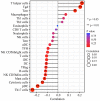Inhibition of UFM1 expression suppresses cancer progression and is linked to the dismal prognosis and immune infiltration in oral squamous cell carcinoma
- PMID: 37980168
- PMCID: PMC10713408
- DOI: 10.18632/aging.205219
Inhibition of UFM1 expression suppresses cancer progression and is linked to the dismal prognosis and immune infiltration in oral squamous cell carcinoma
Abstract
Background: Ubiquitin fold modifier 1 (UFM1) overexpression is associated with cancer cell proliferation, migration and invasion. However, the roles and pathways of UFM1 in oral squamous cell carcinoma (OSCC) has remained undefined.
Methods: The expression of UFM1 and the relationship between UFM1 expression and prognosis were investigated using data of OSCC patients from The Cancer Genome Atlas (TCGA) database. The UFM1 co-expressed genes, and the association between the UFM1 expression and immune cells and ubiquitination were explored. The effects of UFM1 expression on the growth and migration of OSCC cells were investigated by siRNA interference, Cell Counting Kit-8 (CCK-8), Transwell, Western blotting, and wound healing experiments.
Results: UFM1 was highly expressed in OSCC. UFM1 overexpression was associated with short overall survival, disease-specific survival, and progression-free interval, and was an adverse factor for prognosis in OSCC. UFM1-related nomograms were significantly associated with poor prognosis in OSCC patients. Decreased UFM1 expression could inhibit the proliferation, migration, and invasion of OSCC cells. UFM1 was associated with the immune cells (such as the Th17 cells, T helper cells, and cytotoxic cells) and ubiquitination.
Conclusion: Elevated UFM1 expression was associated with poor prognosis, ubiquitination and immune infiltration in OSCC, and inhibition of UFM1 expression delayed OSCC progression, showing that UFM1 could be a biomarker for prognosis and treating OSCC patients.
Keywords: OSCC; UFM1; biomarkers; immune cells; ubiquitination.
Conflict of interest statement
Figures












Similar articles
-
MiR-455-5p suppresses PDZK1IP1 to promote the motility of oral squamous cell carcinoma and accelerate clinical cancer invasion by regulating partial epithelial-to-mesenchymal transition.J Exp Clin Cancer Res. 2023 Feb 3;42(1):40. doi: 10.1186/s13046-023-02597-1. J Exp Clin Cancer Res. 2023. PMID: 36737832 Free PMC article.
-
A novel oncogene trigger transposable element derived-1 promotes oral squamous cell carcinoma progression via evoking immune inhibition.Mol Carcinog. 2023 Aug;62(8):1213-1227. doi: 10.1002/mc.23557. Epub 2023 May 5. Mol Carcinog. 2023. PMID: 37144838
-
ZNF677 inhibits oral squamous cell carcinoma growth and tumor stemness by regulating FOXO3a.Hum Cell. 2023 Jul;36(4):1464-1476. doi: 10.1007/s13577-023-00910-w. Epub 2023 May 2. Hum Cell. 2023. PMID: 37129799
-
Migration and invasion of oral squamous carcinoma cells is promoted by WNT5A, a regulator of cancer progression.J Oral Pathol Med. 2015 Nov;44(10):776-84. doi: 10.1111/jop.12292. Epub 2014 Dec 2. J Oral Pathol Med. 2015. PMID: 25459554
-
Eugenol Inhibits the Biological Activities of an Oral Squamous Cell Carcinoma Cell Line SCC9 via Targeting MIF.Anticancer Agents Med Chem. 2022 Aug 4;22(15):2799-2806. doi: 10.2174/1871520622666220324105435. Anticancer Agents Med Chem. 2022. PMID: 35331101
Cited by
-
Role of UFMylation in tumorigenesis and cancer immunotherapy.Front Immunol. 2024 Aug 23;15:1454823. doi: 10.3389/fimmu.2024.1454823. eCollection 2024. Front Immunol. 2024. PMID: 39247188 Free PMC article. Review.
-
Mithramycin targets head and neck cancer stem cells by inhibiting Sp1 and UFMylation.Cancer Cell Int. 2024 Dec 19;24(1):412. doi: 10.1186/s12935-024-03609-6. Cancer Cell Int. 2024. PMID: 39702263 Free PMC article.
References
Publication types
MeSH terms
Substances
LinkOut - more resources
Full Text Sources
Medical
Molecular Biology Databases

